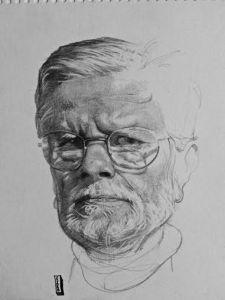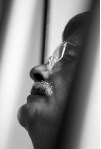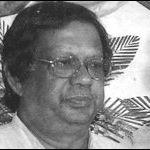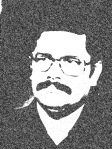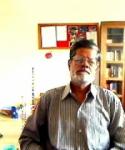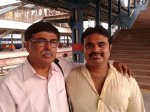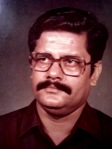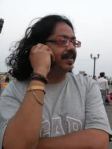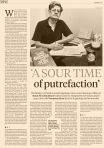Malay Roychoudhury revealed: Part I
Malay Roychoudry is a writer whose rebellious literary past has been well-documented and continues to be researched today. He has had many fascinating experiences, including being a founding member of The Hungry Generation. The BBC have covered the story of this group. Below, Nickie Shobeiry talks to Malay about his life and works.
You grew up in Patna. What was your childhood like, and how do you think it has affected the person you are today?
I was born in a Bengali Brahmin family in 1939, and grew up in Patna in a slum area called Imlitala. Imlitala means ‘below the tamarind tree’. Ours was the only brick-mortar house, and the area all around were hay-hutments of people who at that time were called ‘untouchables’. There were also a few families belonging to pauper Muslims who fled from Lucknow after the city was captured by East India Company. Our family did not have any problems with those ‘untouchables’ and poor Muslims.
During childhood, we were free to enter any house while playing hide-and-seek. We were even allowed to enter the local mosque and the Imam did not object. My photographer/artist Dad was the only earning member looking after a joint, extended family of twenty – my uncles, aunts and cousin brother-sisters resided in the same house. I used to visit the Muslim families for purchasing duck eggs, and they would send us a complete goat leg during Eid. Later my elder uncle got a minion job as Keeper of Paintings and Sculptures at the Patna Museum. During holidays, I would sit on his bicycle and visit the museum for free and roamed around, which contributed a lot to my formative days.
Those who were called ‘untouchables’ did not have any fixed earnings, and we knew they resorted to pick-pocketing, thievery, dacoity etc for a living. There used to be Imlitala Feast where they could lay their hands on something big, and we used to share the community food. Country liquor drinks and palm toddy were in plenty during these feasts, in which I also started sharing from about five-six years age. When the police arrived to arrest anyone, the local dogs used to bark and signal the persons concerned to flee, jumping over tiles of the hutments and disappear into the mango orchard behind.
They used to grow cannabis plants in their courtyard as these were not banned at that time. Obviously we started smoking with them in our teens. Our parents were not that strict to keep us away from the locality we lived in, though there was a limit drawn and that was to sit for our studies in the morning and evening, and show good results in school. In the evening we studied by kerosene lamps, all brothers and sisters together. There was a real horror during our studies in the evening when the people used to kill a leg-tied pig, thrown into a pit and killed with hot iron rods to have its flesh for cooking. The crying yell of the pig was nerve shattering. Being Brahmin we were barred from eating pork, but me and my brother did manage to eat it in the gathering of thieves.
There was no tap for drinking water in our house, and me and my elder brother had to fill up buckets of water from the locality tap. Sometimes we visited the Ganges river to take a bath.
Allen Ginsberg had visited our Dariapur house.
Dad constructed a house in an area of Patna called Dariapur, and as we were reaching adolescence, he wanted us to move out of the almost free-sex Imlitala locality. My first sexual encounter did happen in Imlitala when once I went to purchase eggs from a Muslim family, and there I was virtually raped by the fifteen-year old elder daughter of the house. I was ten and did not know much about sex before that experience. Her name was Kulsum and she loved to recite poems of Ghalib and Faiz. Being from a Brahmin family, beef eating was prohibited for us. I enjoyed the Mughlai beef preparation at their house – she used to lick my lips to clean the trace and smell.
My elder brother Samir was sent to Kolkata, and I was admitted to a Brahmo Samaj Seminary. Samir used to bring Bengali poetry books and novels whenever he arrived from Kolkata. I became sort of a book worm. At the seminary, I developed a crush for the girl-librarian named Namita, who used to suggest novels, short-story books and poetry collections for me. She contributed a lot in making me a writer. I have recorded Kulsum and Namita in my novel, ‘Rahuketu’.
Imlitala has made me an eclectic thinker, morally daring and of tolerant disposition. I think I am ready to accept all Indian social contradictions as natural. I have become broad-minded because of the complex nature of the Imlitala society.
Allen Ginsberg had visited our Dariapur house.
You have now written over forty books. Is there a piece of work (book or otherwise) that is particularly close to your heart? If so, which one and why?
The poem ‘Stark Electric Jesus’, as well as my experimental novel ‘Nakhadanta’, are close to my heart. Lest I forget, the poem in Bengali is titled ‘Prachanda Baidyutik Chhutar’. With ‘Stark Electric Jesus’, I felt I achieved what I intended to do in Bengali poetry, by completely redefining the contemporary form and speed of a poem prevailing during the Sixties. I shall talk about the poem later. ‘Nakhadanta’ is divided in seven parts, on the line of Indian epic poem ‘Ramayana’, and I have tried with the technique of stories within a story on the line of the epic poem ‘Mahabharata’. The stories are about jute farmers and jute mills in West Bengal which are being gradually decimated from the industrial scene due to machinations of political party bigwigs, speculators and jute black marketeers. I had researched and collected actual data of mills and farmer plights/suicides by visiting various villages in West Bengal. Some critics call it postmodern, though I had no such intention while writing Nakhadanta. ‘Nakha’ means fingernail, and ‘Danta’ means teeth.
Oh I’ll die I’ll die I’ll die
My skin is in blazing furorefrom: ‘Stark Electric Jesus’
The Hungry Generation (termed ‘Hungryalism’) revolutionized the Bengali language. Did you imagine that this would happen, on the scale that it has, when the movement first began?
To be frank I did not, and neither did any other founding members of the literary movement ever think that it would reach shores of other languages, and become a topic of academic and media interest. When it started, we were attacked by the print media, and serious literary periodicals made fun of the movement. Posters drawn by Anil Karanjai and Subimal Basak were ripped out of the wall of Kolkata Coffee Houses by other literary groups. Members of a group named ‘Krittibas’ encircled Subimal Basak in front of coffeehouse one evening, and resorted to a fisticuff, resulting into a sort of gang war. Some aged intellectuals and editors secretly wrote letters against us to the Police Commissioner which was later revealed to us by the Commissioner himself.
You might have read that we did not publish regular periodicals for about three years, and published and freely distributed a one-page manifesto/bulletin in Kolkata colleges, newspaper offices and coffeehouses until 1963. The Police Commissioner of Kolkata who interrogated Samir and I sarcastically asked us if we were selling tooth powder through handbills, or if we were engaged in serious literary activities.
The movement gathered steam in 1963-64 when about 35 participants, including painters, joined. In fact, we did not approach the BBC or the Wesleyan University, the University of Ohio, the Gutenberg University or for that matter any of the Indian Universities. The PhD and MPhil that students are writing about us are doing it of their own accord. In most cases, the researchers do not approach us at all, and collect material from The Little Magazine Library and Research Centre at Kolkata. I gather that the movement had a great impact in Bangladesh where Bengali is the national language. My poem ‘Stark Electric Jesus’ is being debated since 2008 on a website of Dhaka.
Could you give an example in the way that the Bengali language has changed due to the movement ?
Prior to our movement all novels and stories used to be close ended. Poems used to have a centre identified by the title, and street lingo was not used to compose sentences. Slangs were never used, foul language was a taboo and novels were mostly European in construct, and in the sense that the entire narrative was built around a so-called hero. Compound sentences were avoided, short stories always had a whip-crack ending, the concept of ‘The Outsider’ was not touched upon, and lower-caste writers were completely absent in literary periodicals (Subimal Basak, Debi Roy, Abani Dhar in our movement belonged to lower castes). Poems never dealt with images in flux, logical cracks in sentences were frowned upon, and form of the narrative was not freed. There was more concentration on plot and content than on language and technique, and the usage of micro narratives within narratives were considered non-literary. We did away with all these, and allowed the author total freedom. We felt that the European modernism did not suit the Indian complex spirit, and we should draw more from ancient Indian puranas.
In 1961, in the home you shared with your elder brother, Hungryalism was born. Can you recall the first time you realised what you were doing was important?
Actually, it was our parents’ house. I used to discuss with Samir the economic and cultural conditions of society as a result of the shift by the Government of India from an agrarian development plan to a massive industrialisation plan, in the background of an influx of millions of refugees as a result of partition of the country. I was also preparing a draft for a book on Marxism while writing a monthly column on ‘Philosophy of History’ in a Kolkata literary periodical. We felt there was a complete downslide in Bengali society in particular, and Indian society in general, and we should start a movement which should deal with non-literary aspects as well. We felt there has to be a push to get the society out of its elitist slumber. The existing cultural structure was not suitable to solve problems – there had been unimaginable changes in socio-economic environment due to the partition of Bengal.
When the movement picked up steam in 1963 and we were being attacked on all fronts, we realised that what we were doing was quite important, and that we had to keep our critique in focus. Hungryalism became a cultural phenomena. We had to express rage against the system that demanded conformity and selling out.
Our disgust of European modernism automatically became a problem for the reigning writers, poets and thinkers of the 1930s, 40s and 50s. A famous Bengali poet and editor of a poetry magazine, Buddhadeva Basu, refused to meet me and shut the door in my face. In almost all anthologies edited by pre-1960 writers, Hungryalists were never included.
Chaucer and German history philosopher Oswald Spengler influenced the conception of Hungryalism. Why in particular these two writers?
In view of the plight of the refugees on the streets and railway platforms of Kolkata, we wanted to use a word that typified the Sixties’ bad time. Geoffrey Chaucer was in my undergraduate course, and I remembered his line “In the sowre Hungry tyme.” Hungry Time was what we were searching for, and thus we got the name Hungry Generation, or Hungryalism. I discovered Oswald Spengler while writing my column on the Philosophy of History. He had said that when a culture is in downslide, it starts eating everything from the outside – its hunger is insatiable. Thus these two fit exactly to what we were looking for. We discussed it with Samir’s poet friend, Shakti Chattopadhyay, and my poet friend, Debi Roy. We did not, however, agree with Spengler’s sense of doom. Just look at present day India. Our readings were almost prophetic in view of what we wrote in our religious and political manifesto.
Nickie Shobeiry

